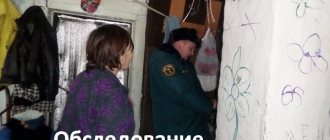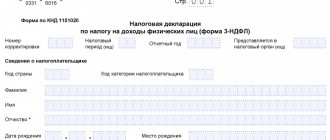Drawing up a Premises Inspection Report occurs in different cases: during purchase and sale, rental, repair work, after flooding and other unforeseen force majeure circumstances. The act is drawn up both during the inspection of residential premises and non-residential objects (warehouses, industrial buildings, offices, etc.).
The main reasons for drawing up an act are the need to confirm or refute any harm caused to the premises, or to describe the condition of the premises at a certain point in time without reference to any event.
Acts on inspection of premises are divided into two types:
- optional (for property transactions),
- mandatory (when conducting forensic examinations, investigative activities and investigations).
- Form and sample
- Free download
- Online viewing
- Expert tested
FILES
Premises inspection procedure
As a rule, several people are involved in the inspection procedure of the premises. All their data must be included in the inspection report of the premises.
There is no strictly regulated, legally approved procedure for inspecting the premises. Typically, such an inspection occurs for a specific purpose, for example, checking the technical condition, electrical equipment, communication networks, monitoring compliance with fire, environmental safety rules, etc.
Therefore, not one person, but several (at least two) are involved in the process, that is, a special commission is created. It often includes representatives of supervisory departments and government agencies, including engineers, technicians, and experts. This approach ensures the objectivity of the inspection and the reliability of the commission’s conclusions.
Functions
The inspection report solves the following tasks:
- Recording of detected damage that can be seen with the naked eye.
- Documentary confirmation of complete equipment.
- Confirmation that the equipment is in working order.
- Establishing compliance of devices with the technical passport.
- Documentary confirmation that the equipment meets fire and sanitary safety standards.
Inspections can be either one-time or regular. But, in any of these cases, it is necessary to draw up an act. It performs these functions:
- Prevention of production failures/breakdowns.
- Establishing that the equipment can be operated.
Inspection is the most important element needed to ensure safety. Based on the certificate, the equipment is put into operation. If the commission cannot give permission to use the equipment, the act must contain the grounds for refusal. In particular, the document must contain these provisions:
- Degree of wear.
- Defects found.
- Approximate cost of eliminating detected defects.
- Approximate time frame for repair work.
Sometimes detected defects cannot be corrected. In this case, based on the inspection report, the equipment is written off from the company’s balance sheet.
Basic rules for drawing up an act
There is no unified, single template for drawing up this document, so you can write it in free form. You can fill out the act by hand or print it on a computer. The main thing is that it contains information about the object being inspected, information about the members of the inspection commission, an accurate description of their conclusions, as well as comments and shortcomings identified during the procedure. If an inspection of the premises is carried out to establish the fact of damage, then this must also be noted, indicating the cause, the alleged culprit, as well as the identified cause-and-effect relationships.
The document can be created in a descriptive form, or it can be compiled in the form of a table.
The more complex the structure of the inspected premises is, the more ambitious the objectives of the inspection are, the more voluminous and broad the act becomes.
Sometimes separate annexes are attached to the act - they must also be indicated in the main document.
Quite often, during inspections, the object is photographed, and then the photographs are also included in the act as attachments. If, during the inspection of the premises, electrical equipment, ventilation, heating and water supply systems are checked, the report must certify that their condition complies with established norms and standards.
The act is drawn up in several copies - one for each of the interested parties. Each copy of the act must be certified by the original signatures of the members of the commission conducting the inspection, and also certified by the seals of the relevant organizations. A correctly drawn up act acquires legal force and can serve as evidence in court.
Typical and recommended forms of a defect report
Download the recommended forms of defective reports for write-off (repair) of OS (equipment) on our website:
- Defective report for repair of fixed assets (equipment)
- Defective act on write-off of fixed assets (equipment)
A standard form of form No. OS-16 is available for download in the article “Unified form No. OS-16 - form and sample” .
Instructions for writing a premises inspection report
The act is drawn up according to standard office work rules, so it should not cause any special difficulties.
- In the “header” of the document in the middle, its name is written and the essence is briefly indicated (in this case, “inspection of the premises”), and the locality in which it is being drawn up and the date : day, month (in words), year.
- Then the composition of the commission that conducts the inspection is entered: the position of each member of the commission, the full name of the organization that he represents, last name, first name, patronymic are indicated.
- Next, information related to the object itself . Here you need to enter information about its name and purpose, indicate the owner, as well as the address where it is located.
- The commission's conclusions are published below : if the premises and all inspected elements are in good condition, then this should be noted, but if there are any complaints or comments about its condition, then they should be described in as much detail as possible.
- In the final part of the act, it must be signed by all members of the formed commission and, if necessary, certified with seals.
Form
To draw up such an act there is no need to use a unified form. The document is drawn up in a free style. The main thing you need to pay attention to here is the indication of all important information. This is a detailed description of the apartment and the parties who are parties to the transaction. As a rule, the parties choose the most suitable form in advance by mutual agreement.
When and why do you need an apartment inspection report?
Using the deed, the parties document the condition of the property. Conventionally, the inspection report can be divided into two types:
- Required . In this case, there is no way to do without an inspection. As a rule, such situations arise during investigations, investigative or judicial audits.
- Optional . When citizens or organizations transfer an apartment from hand to hand, for example, when selling, renting or donating, drawing up a deed is desirable. But it cannot be called mandatory, because the law allows you to do without this document.
Although practice shows that recently even individuals are trying to properly prepare such a document. After all, it is this act that will be considered first if any disagreements arise between the parties. For example, if we are talking about selling an apartment, its inspection is in the interests of all interested parties:
- The seller of the apartment needs an inspection report so that he has documentary evidence of this fact. Also, taking into account the collected acts, the seller may decide to change the terms of sale. If the buyer agrees to sign the inspection report, this will indicate that he is completely satisfied with the condition of the home. Accordingly, if after the transaction the buyer wishes to make any claims, this act will be a weighty argument in favor of the seller.
- Realtor, if the seller resorted to his services. Based on this document, he reports to the seller, since the time and date of the inspection must be indicated here. Information about the buyer is also noted. With the help of this act, the realtor will be able to prove that he was the one who found the buyers.
- The buyer practically does not need an inspection certificate. Although you may encounter a situation where law enforcement agencies have questions. For example, if this apartment was robbed, the buyer will have documentary evidence of the reason why he was here.
- The tenant will need this document when he returns the apartment to the owner. The act will confirm that the technical condition of the premises has not changed.
- To the landlord when he rents out the property. After a certain period of time, he will be able to check whether the condition of the apartment has worsened. If it has changed for the worse, the owner may demand compensation from the tenant for damages.
Inspection report on living conditions of a minor
› Housing issue › Housing and communal services › How to fill out an inspection report on housing and living conditions.
21.09.2020
The act of examining the living conditions of a dysfunctional family is one of the documents on the basis of which conclusions are drawn about the need to provide support from the state or take appropriate measures to correct the situation. The preparation of such a document is characterized by certain features, knowledge of which will allow you to avoid negative consequences and obtain the expected result.
What kind of certificate is this: why is it needed, who issues it?
An inspection report regarding the clarification of the characteristics of a family’s living conditions is often drawn up by guardianship authorities and other monitoring organizations in order to identify violations of generally accepted norms.
This type of document is considered mandatory in the following circumstances:
- citizens expressed their intentions to adopt a child;
- it is necessary to take the minor into custody;
- there are suspicions of parental dishonesty;
- the child is registered with the IPD.
Such situations are often associated with the following circumstances:
- identifying facts of child abuse;
- non-compliance with hygiene by minors;
- serious problems with academic performance;
- lack of proper conditions for education;
- antisocial lifestyle of parents.
The act is often required when moving and selling real estate on the territory of which a minor is registered or he is one of the owners of the premises. Such a document allows you to make sure that the parents conscientiously fulfill their responsibilities and the rights of the child will not be infringed during the property transaction.
Often, the initiators of obtaining a certificate are citizens forced to live in dilapidated or dilapidated housing. Recognition of conditions as unsuitable allows them to receive the status of those in need of improved conditions and count on receiving assistance from the state. It can be expressed in the provision of a more comfortable property for living or the allocation of a subsidy, which can be spent on the purchase of other real estate.
The procedure for drawing up an inspection report on social and living conditions
The inspection report can be drawn up by specialists from various departments, depending on the circumstances that required its execution. The result will be a positive or negative conclusion, on the basis of which appropriate conclusions will be made.
In practice, the following options are possible:
- OOiP - receipt of an application about the desire to adopt a child or act as a guardian, the need to verify the fact of improper performance of the duties of legal representatives, raising the issue of deprivation of parental rights and the need to place a minor in a specialized institution;
- Educational organizations - a child’s poor academic performance, the appearance of inappropriate or aggressive behavior on the part of a student, the unkempt appearance of a minor or complaints on his part about mistreatment in the family;
- Medical institutions - recording signs of child abuse, suspicions of abuse and violence;
- Rospotrebnodzor - violations of sanitary and epidemiological standards in the premises, complaints from neighbors about the creation of an unfavorable living environment by residents;






